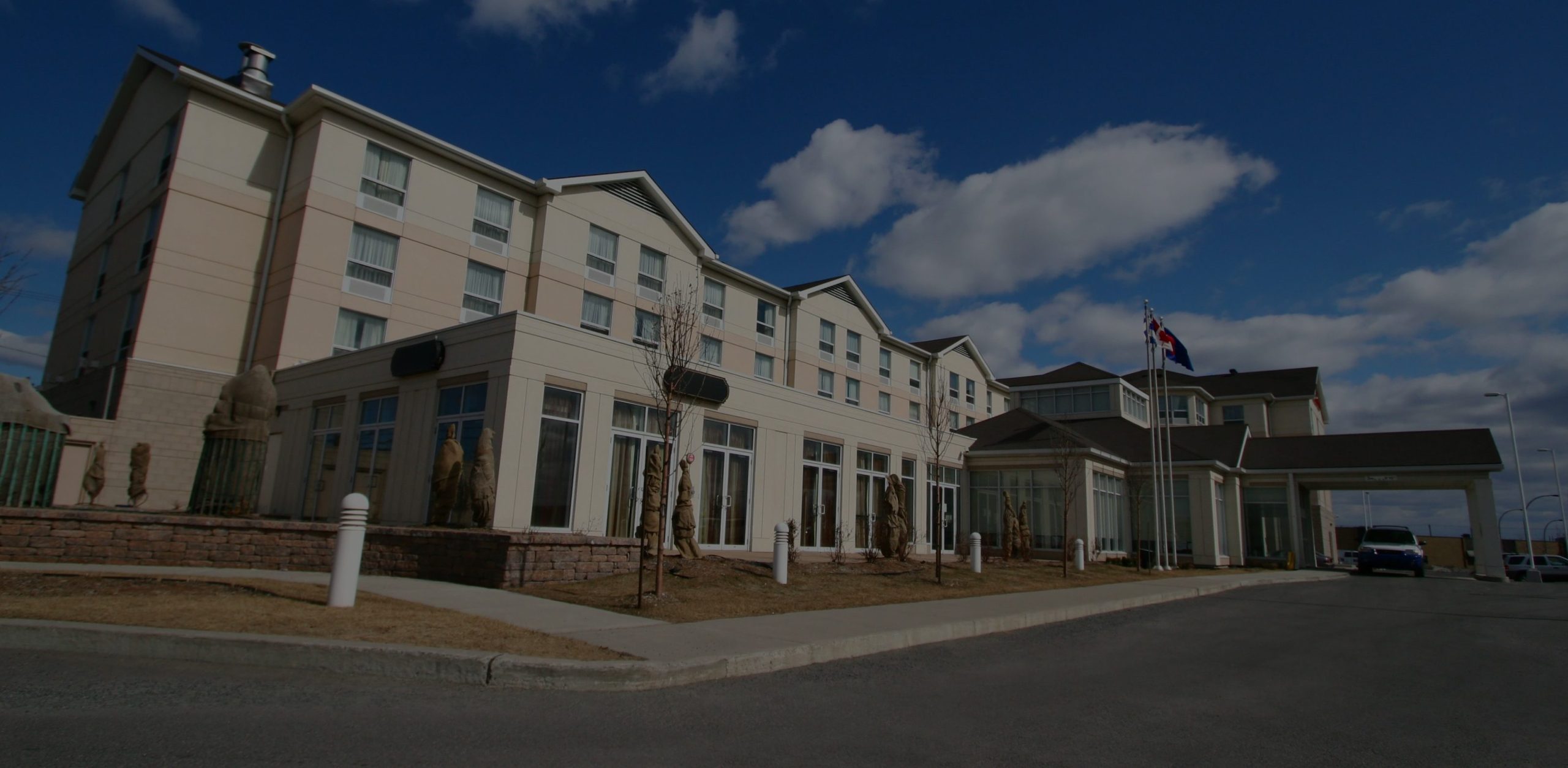
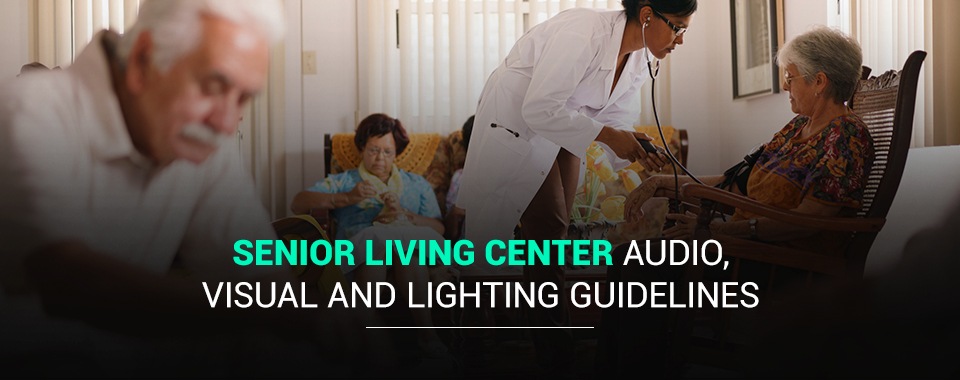
Senior living centers, also called long-term care facilities, are home to millions of seniors in the U.S. These centers include residential care facilities, assisted living, nursing homes and continuing care retirement communities. With so many older adults relying on these centers for medical care, socialization and entertainment, it’s paramount that your audio, visual and lighting setup meets their needs.
At Illuminated Integration, we believe that all AVL systems should be as accommodating as possible. Whether you’re replacing your existing AVL system or integrating a new build from square one, our experts want to help you follow the best senior living center design guidelines and practices. Let’s identify a few design elements to keep in mind when designing an audio, video and lighting system for a senior living facility.
When designing the AVL elements of a senior living center, it may be most beneficial to use a customized approach. Regardless of whether your facility is independently owned or part of a larger company, your community’s needs must be addressed as uniquely as possible. For example, the directional placement of your facility’s windows can have a dramatic impact on how artificial and natural light differ from the common rooms to the bedrooms. Senior living center acoustic considerations and any video components are also top priorities.
As you begin to consider how the audio, visual and lighting systems will impact your senior care center, you must take into account your short-term and long-term goals. Senior living centers today are more technologically integrated than ever before, and these capabilities will only increase over time. You’ll want to consider specific immediate needs, such as better lighting throughout the facility, as well as plans for the future, such as creating a small worship or theater area for dedicated events.
Ultimately, the design guidelines you’ll use to create the most inclusive AVL installation for your community will be those that cater to the evolving physical needs of these men and women. This means taking into consideration the changes in hearing and sight that most aging adults will face. Following the best senior citizen design guidelines prioritizes the safety of those living in your community, and these careful considerations also maximize the level of safety for visitors and employees.
There are many points to consider when designing a long-term care facility to cater to the needs of aging populations. One of the obstacles many older men and women face involves audio levels. Whether it’s the sound quality from a speaker system or the ability to hear conversations with ease in a common area, those living in a senior community center may have difficulties hearing clearly in these spaces. These potential hearing challenges should inform your design.
Hearing loss is quite common among men and women of all ages in the United States. Naturally, rates increase as the population ages, which means your senior living center may be filled with those experiencing gradual hearing loss as they get older and those who have lived with auditory disorders for significant portions of their lives. Although hearing aids could benefit those experiencing hearing loss, a small percentage of older adults utilize this resource. This means that your facility may need to compensate.
There are a number of ways in which a decrease in the ability to hear sufficiently can impact an older adult. Some may be able to hear high pitches better than low pitches. Others may be able to hear well in a one-on-one conversation in an intimate space but have significant trouble discerning voices when having a conversation in a crowded, noisy space.
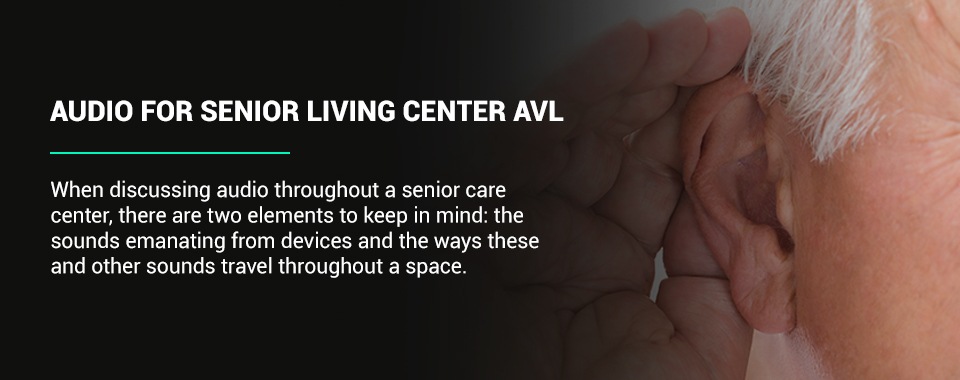
When discussing audio throughout a senior care center, there are two elements to keep in mind: the sounds emanating from devices and the ways these and other sounds travel throughout a space. These elements will interact with a space differently depending on the context. For instance, the audio needs of a common room or dining area will require certain acoustic considerations. Important factors to consider include:
Many aging adults experience vision problems that are difficult to overcome once they’ve reached a certain point. Even those with glasses, contacts or corrective surgeries may still see a decline in their vision as they age. With that in mind, it’s vital the lighting and visual elements of your senior center assist these inpiduals as effectively as possible.
As we age, our vision begins to decline. This includes how we perceive clarity, color and depth. We rely on our sight to help inform our thoughts and actions. Without the ability to clearly see, perceive and interpret what’s in front of us, we are put at a disadvantage. Aging adults are more likely to see their vision decline between their 40s and 60s. That means many of your community members may be developing significant visual impairments.
Older adults are more likely to experience a decline in visual perception as well. Visual impairments, including the inability to perceive depth, increase the risk of falls.
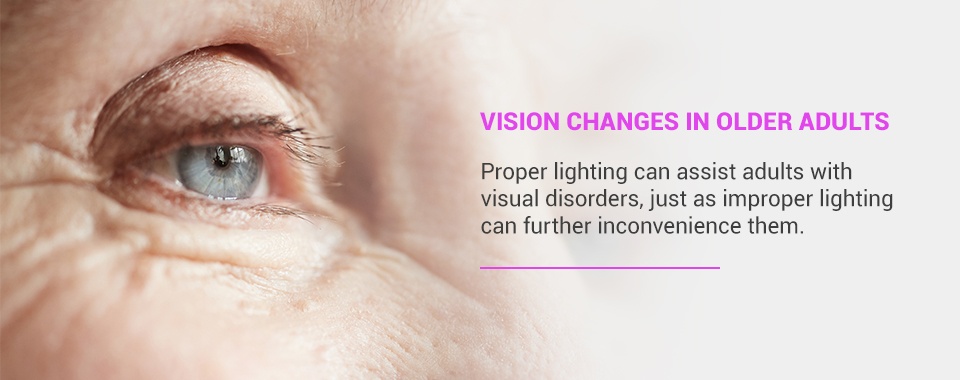
Changes in vision as we age are one of the most impactful shifts in our day-to-day lives. Even the healthiest of adults can develop vision disorders after they turn 60 such as cataracts, retinal detachment, glaucoma, dry eye, age-related macular degeneration and diabetic retinopathy. These disorders may occur in addition to the general decrease in vision performance that most aging adults experience. Proper lighting can assist adults with visual disorders, just as improper lighting can further inconvenience them.
When it comes to designing any visual elements of your residential senior care center, there are a number of factors to consider. Because so many men and women may have different levels of visual impairment, it’s important to realize that providing the best visual elements will involve:
Perhaps the most important part of your AVL design is your lighting system. Take a moment to list all the times throughout the day you utilize artificial lighting. From the bedroom and bathroom to the office and grocery store, we require varying degrees of artificial light throughout the day and night. Light is a necessity for all aspects of our lives, and it’s an even more vital resource for aging adults.
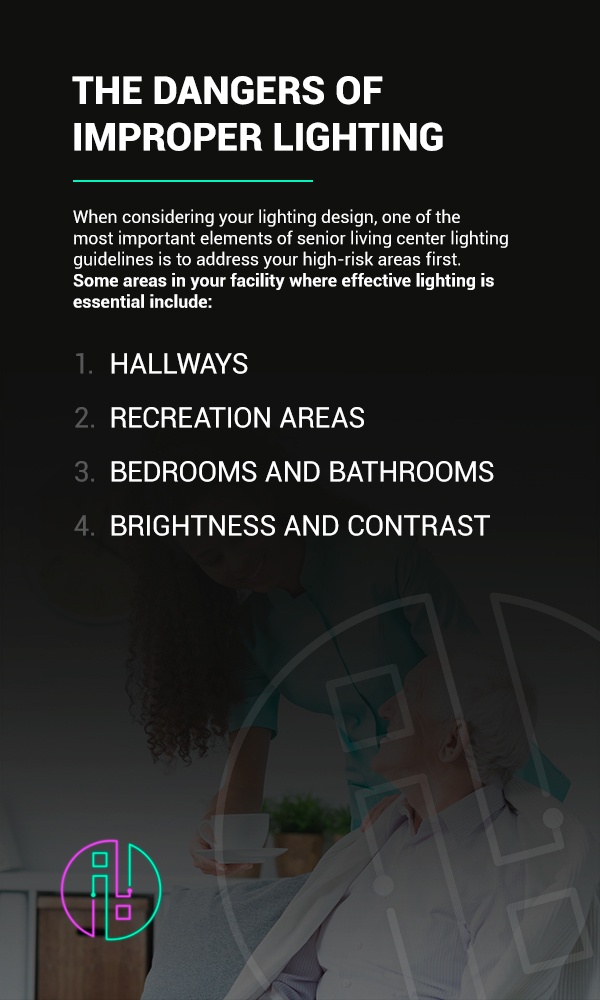
An aging adult is treated in the emergency room for injuries sustained during a fall every 11 seconds. One of the causes of these falls is improper lighting. Studies have shown that fall risk is increased when adults are changing positions such as sitting, standing or laying down. Thankfully, proper lighting can improve balance in older adults, including those who are and are not at risk for falls. Improper lighting can include too little lighting and too much lighting.
When considering your lighting design, one of the most important elements of senior living center lighting guidelines is to address your high-risk areas first. Although there are various aspects of a room that create falling hazards, the ways in which lighting illuminates the floors, ceilings and other structures in a room must also be considered. Improper lighting can increase chances for injury even in spaces that normally would be considered low-risk areas. Other areas in your facility where effective lighting is essential include:
Improper lighting is a danger for residents, guests and employees of your facility. Poor lighting, which includes too little and too much illumination, can create improper contrast, poorly distributed light and glares. Even if your lighting system provides the correct level of lighting, a malfunctioning system that causes flickering can also be hazardous.
Whether you provide assisted living to seniors or more intensive nursing care, it’s important that you invest the time and thought into making your facility as inclusive for their evolving needs as possible. At Illuminated Integration, we understand the perse needs that aging adults in senior living communities require. AVL systems are great resources for socialization and entertainment, and they also perform vital functions that play a crucial role in seniors’ day-to-day lives.
Our AVL design experts are experienced in creating custom AVL solutions for senior living centers, including nursing homes, assisted living centers and independent living facilities. We’ll sit together and design your custom AVL build from scratch, creating a system that meets your unique needs. With your input every step of the way, you’ll have the versatile AVL system you need that’s an easy-to-use, turnkey solution. When the setup is complete, only minimal training is required to get your staff completely comfortable operating all audio, visual and lighting components.
Illuminated Integration’s commitment to delivering the most dynamic, customized AVL solutions doesn’t end when the project is completed. Our goal is to ensure your complete satisfaction long after we’ve completed your custom build. You’ll receive our world-class customer service at a moment’s notice. If you ever have any questions or problems or need to scale your AVL system to accommodate your community, our team is ready to serve. Just give Illuminated Integration a call, and we’ll work to resolve your issues.
Your senior care center provides invaluable services to an important population in your community. When integrating AVL systems into these spaces, it’s important to always keep your residents in mind. As adults age, their audio and visual needs change. By taking the time to incorporate an inclusive AVL design into your senior living center, you ensure you provide these men and women the support they need.
We can help you make the audio, visual and lighting components of your center as inclusive and effective as possible. Contact Illuminated Integration today to learn more about inclusive senior living center design guidelines for AVL systems.